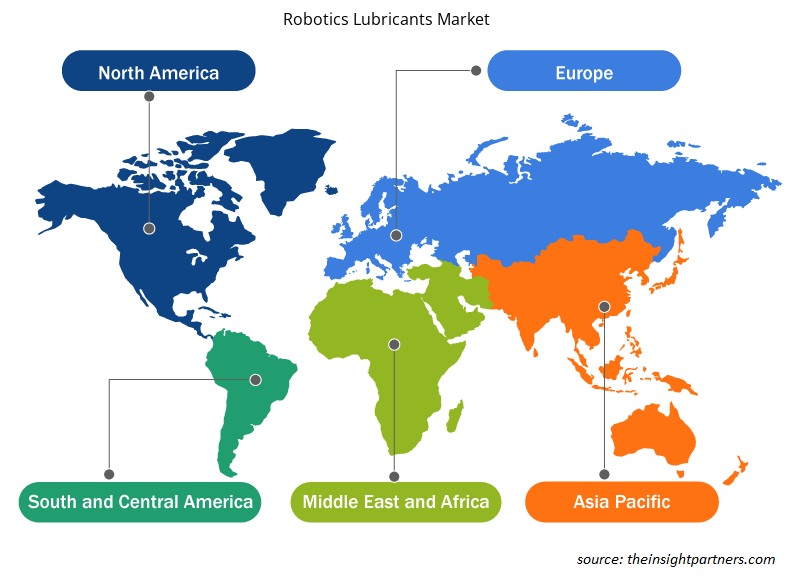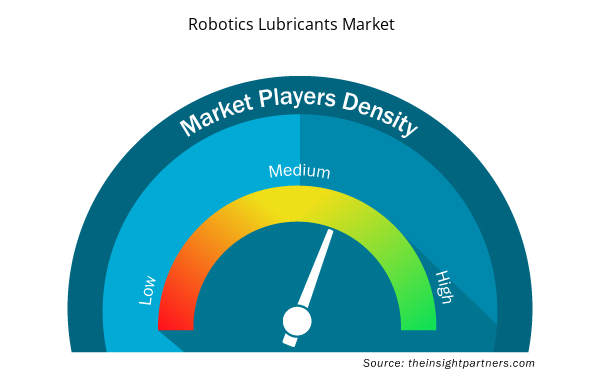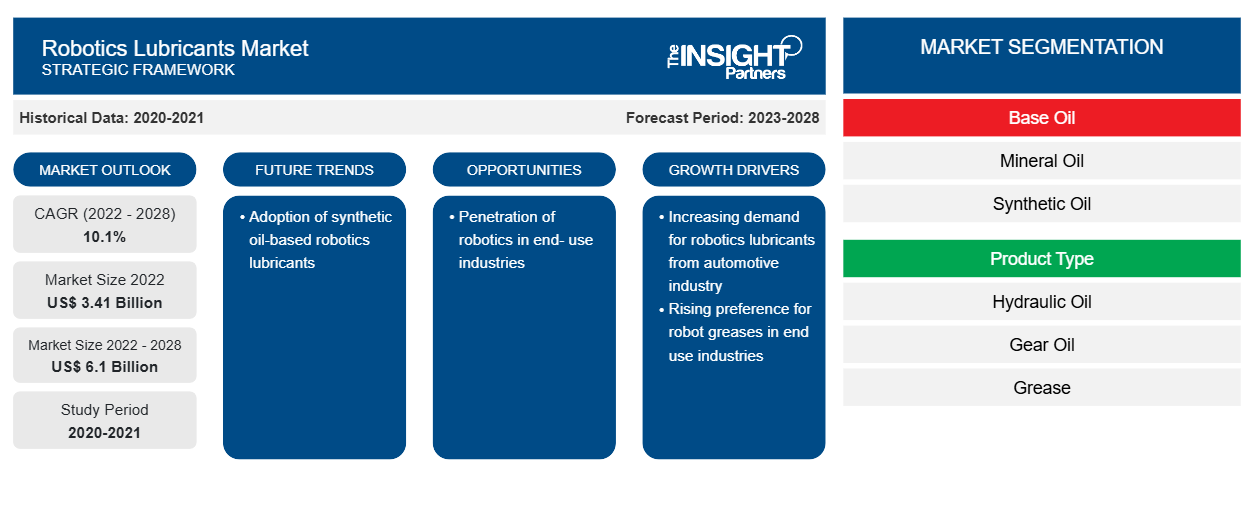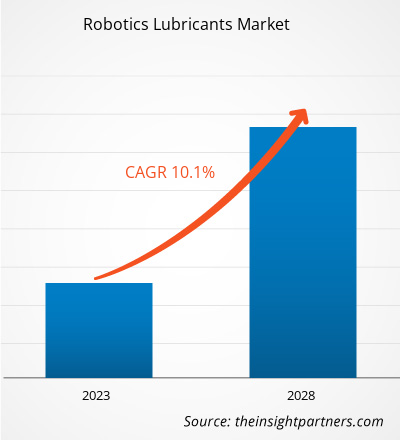[تقرير بحثي] من المتوقع أن ينمو حجم سوق زيوت التشحيم الروبوتية من 3،413.72 مليون دولار أمريكي في عام 2022 إلى 6،095.41 مليون دولار أمريكي بحلول عام 2028؛ ومن المتوقع أن يسجل معدل نمو سنوي مركب بنسبة 10.1٪ من عام 2022 إلى عام 2028.
تحليل السوق
تُستخدم مواد التشحيم لتقليل الاحتكاك بين الأسطح والحرارة المتولدة، مما يزيد من عمر الأسطح المعنية. تشارك الروبوتات الصناعية في مناولة المواد وتجميعها وتوزيعها، مما يجعلها معرضة لتأثيرات التآكل والتآكل. يتم تطوير مواد التشحيم للروبوتات للمساعدة في تقليل وقت تعطل الروبوتات الصناعية والتأثير بشكل إيجابي على الجودة والتكاليف وكفاءة عملية التصنيع. تتكون مواد التشحيم من مجموعة متنوعة من السوائل لتحمل الظروف القاسية. الشحم هو مادة تشحيم تستخدم على نطاق واسع لعمليات الروبوتات.
محركات النمو والتحديات
لقد ساعد الطلب المتزايد على زيوت التشحيم للروبوتات في صناعات الاستخدام النهائي على نمو سوق زيوت التشحيم للروبوتات . في قطاع التصنيع، يعد زيت التشحيم للروبوتات أحد المكونات الرئيسية التي تساعد المعدات على العمل بأقصى قدر من الموثوقية وبأعلى قدر من الكفاءة. تُستخدم الشحوم والزيوت الهيدروليكية وزيوت التروس في العديد من الصناعات ذات الاستخدام النهائي، بما في ذلك صناعة السيارات والكهرباء والإلكترونيات والأغذية والمشروبات والخدمات اللوجستية وتصنيع المعادن والآلات. تحتوي شحوم الروبوتات على زيت أساسي مثل الزيت المعدني أو الزيت الاصطناعي والمكثف والمواد المضافة، والتي تضفي صفات مميزة للمنتج. تمتلك الشحوم العديد من الخصائص مثل القدرة على الختم، وانخفاض ميل التسرب، والحماية من التآكل، والتعامل مع الأحمال الثقيلة. العديد من شحوم الروبوتات المتوفرة تجاريًا هي من الدرجة الغذائية وتتوافق مع معايير دولية معينة لصناعات محددة مثل الأغذية والمشروبات والطب والرعاية الصحية. يتدهور الشحم بسبب الاحتكاك والتعرض لدرجات حرارة شديدة حتى تصبح مستويات اللزوجة غير كافية لتزييت المكونات الميكانيكية الداخلية بشكل فعال. يعد تشحيم الروبوت جزءًا لا يتجزأ من الحفاظ على الكفاءة الإجمالية للروبوتات ومكوناتها. يختلف التردد الموصى به لتزييت الروبوتات حسب العلامة التجارية والطراز. وبالتالي، فإن مزايا الشحوم مقارنة بزيوت التشحيم الأخرى وتفضيل شحوم الروبوتات من الصناعات ذات الاستخدام النهائي هي التي تدفع سوق زيوت التشحيم للروبوتات. ومع ذلك، أدت التقلبات في الظروف الاقتصادية العالمية إلى زيادة تكاليف المواد المضافة والمخزونات الأساسية والنقل والتصنيع. وشهد العديد من الشركات المصنعة ضغوطًا تضخمية بالإضافة إلى إمدادات إضافات زيوت التشحيم عبر سلسلة توريد زيوت التشحيم. في عام 2022، ارتفعت أسعار الزيوت الأساسية في الولايات المتحدة من 2 دولار أمريكي للغالون إلى 5 دولارات أمريكية للغالون. علاوة على ذلك، في عام 2022، أعلنت شركة FUCHS Lubricants Co عن زيادة في الأسعار بنسبة 8-12٪ لمحفظة إضافات زيوت التشحيم الخاصة بها، والتي تم تنفيذها اعتبارًا من أكتوبر 2022. علاوة على ذلك، في عام 2022، زادت شركة Ergon Inc أسعار زيت القاعدة النفثينية. ومع ذلك، في عام 2023، أعلنت شركة Chevron Corporation عن انخفاض في سعر الزيت الأساسي بمقدار 0.20 إلى 0.50 دولار أمريكي. ومن ثم، فإن التقلبات في أسعار المواد الخام تعمل على تقييد نمو سوق زيوت التشحيم الروبوتية.
قم بتخصيص هذا التقرير ليناسب متطلباتك
ستحصل على تخصيص لأي تقرير - مجانًا - بما في ذلك أجزاء من هذا التقرير، أو تحليل على مستوى الدولة، وحزمة بيانات Excel، بالإضافة إلى الاستفادة من العروض والخصومات الرائعة للشركات الناشئة والجامعات
- احصل على أهم اتجاهات السوق الرئيسية لهذا التقرير.ستتضمن هذه العينة المجانية تحليلاً للبيانات، بدءًا من اتجاهات السوق وحتى التقديرات والتوقعات.
تقسيم التقرير ونطاقه
"تحليل سوق زيوت التشحيم الروبوتية العالمية حتى عام 2028" هي دراسة متخصصة ومتعمقة مع التركيز بشكل رئيسي على اتجاهات سوق زيوت التشحيم الروبوتية العالمية وفرص النمو. يهدف التقرير إلى تقديم نظرة عامة على سوق زيوت التشحيم الروبوتية العالمية مع تقسيم السوق التفصيلي حسب الزيت الأساسي ونوع المنتج وصناعة الاستخدام النهائي والجغرافيا. شهد سوق زيوت التشحيم الروبوتية العالمية نموًا مرتفعًا خلال الماضي القريب ومن المتوقع أن يستمر هذا الاتجاه خلال فترة التنبؤ. يقدم التقرير إحصائيات رئيسية حول استهلاك زيوت التشحيم الروبوتية في جميع أنحاء العالم جنبًا إلى جنب مع الطلب عليها في المناطق والبلدان الرئيسية. بالإضافة إلى ذلك، يقدم التقرير التقييم النوعي للعوامل المختلفة التي تؤثر على أداء سوق زيوت التشحيم الروبوتية في المناطق والبلدان الرئيسية. يتضمن التقرير أيضًا تحليلًا شاملاً للاعبين الرائدين في سوق زيوت التشحيم الروبوتية وتطوراتهم الاستراتيجية الرئيسية. كما تم تضمين العديد من التحليلات حول ديناميكيات السوق للمساعدة في تحديد العوامل المحركة الرئيسية واتجاهات السوق وفرص سوق زيوت التشحيم الروبوتية المربحة والتي من شأنها بدورها أن تساعد في تحديد جيوب الإيرادات الرئيسية.
علاوة على ذلك، يوفر تحليل النظام البيئي وتحليل القوى الخمس لبورتر رؤية بزاوية 360 درجة لسوق زيوت التشحيم الروبوتية العالمية، مما يساعد على فهم سلسلة التوريد بأكملها والعوامل المختلفة التي تؤثر على نمو السوق.
التحليل القطاعي
يتم تقسيم سوق زيوت التشحيم العالمية للروبوتات على أساس الزيت الأساسي ونوع المنتج وصناعة الاستخدام النهائي. بناءً على الزيت الأساسي، يتم تقسيم سوق زيوت التشحيم للروبوتات إلى زيت معدني وصناعي وغيرها. بناءً على نوع المنتج، يتم تصنيف السوق على أنه زيت هيدروليكي وزيت تروس وشحم. بناءً على صناعة الاستخدام النهائي، يتم تصنيف السوق على أنه صناعة السيارات والأغذية والمشروبات والطب والرعاية الصحية والكهرباء والإلكترونيات والمعادن وغيرها من الصناعات التحويلية.
بناءً على الزيت المعدني، استحوذ الزيت المعدني على حصة كبيرة في سوق زيوت التشحيم للروبوتات. توفر العديد من شركات تصنيع زيوت التشحيم زيوت تشحيم متعددة الأغراض للتطبيقات في مكونات التروس الروبوتية والسلاسل والمحامل والوصلات الملولبة. تقدم شركة Castrol Ltd زيوت تروس معدنية، بما في ذلك Optigear ALR 320 وOptigear BM 100 وAlpha SP 320، لجميع التطبيقات المحورية الروبوتية أو الانتقائية. على أساس نوع المنتج، قاد قطاع الشحوم سوق زيوت التشحيم للروبوتات بأكبر حصة في السوق. بناءً على صناعة الاستخدام النهائي، استحوذت صناعة السيارات على حصة كبيرة في سوق زيوت التشحيم للروبوتات. من المتوقع أن يسجل قطاع الكهرباء والإلكترونيات أسرع معدل نمو سنوي مركب خلال فترة التنبؤ.
التحليل الإقليمي
يقدم التقرير نظرة عامة مفصلة على سوق زيوت التشحيم الروبوتية العالمية فيما يتعلق بخمس مناطق رئيسية، وهي أمريكا الشمالية وأوروبا وآسيا والمحيط الهادئ (APAC) والشرق الأوسط وأفريقيا (MEA) وأمريكا الجنوبية والوسطى. استحوذت منطقة آسيا والمحيط الهادئ على حصة كبيرة من السوق وبلغت قيمتها أكثر من 1.9 مليار دولار أمريكي في عام 2022. تعد منطقة آسيا والمحيط الهادئ سوقًا بارزة لزيوت التشحيم الروبوتية بسبب النمو في قطاعي السيارات والإلكترونيات وارتفاع التصنيع، مما أدى إلى زيادة الطلب من قطاع التصنيع. ومن المتوقع أيضًا أن تشهد أوروبا نموًا كبيرًا يصل إلى أكثر من 1.2 مليار دولار أمريكي في عام 2028، ويعزى ذلك إلى الاستخدام المتزايد لزيوت التشحيم الروبوتية في صناعة الكهرباء والإلكترونيات. ومن المتوقع أن تنمو أمريكا الشمالية بمعدل نمو سنوي مركب يبلغ حوالي 9٪ من عام 2022 إلى عام 2028.
تطورات الصناعة والفرص المستقبلية
تبين أن الشراكات والاستحواذات وإطلاق المنتجات الجديدة هي الاستراتيجيات الرئيسية التي يتبناها اللاعبون العاملون في سوق زيوت التشحيم الروبوتية العالمية.
في أبريل 2023، أطلقت شركة FUCHS شحم "RENOLIT ROBO-G 0" لتزييت الروبوتات. وهو شحم شبه سائل شديد الضغط (EP) يعتمد على صابون مركب الليثيوم والزيت المعدني. المنتج مخصص للاستخدام في التروس الدقيقة مثل الروبوتات الصناعية وأدوات الماكينة والطاولات المستديرة.
رؤى إقليمية حول سوق زيوت التشحيم الروبوتية
لقد قام المحللون في Insight Partners بشرح الاتجاهات والعوامل الإقليمية المؤثرة على سوق زيوت التشحيم للروبوتات طوال فترة التوقعات بشكل شامل. يناقش هذا القسم أيضًا قطاعات سوق زيوت التشحيم للروبوتات والجغرافيا في جميع أنحاء أمريكا الشمالية وأوروبا ومنطقة آسيا والمحيط الهادئ والشرق الأوسط وأفريقيا وأمريكا الجنوبية والوسطى.

- احصل على البيانات الإقليمية المحددة لسوق زيوت التشحيم الروبوتية
نطاق تقرير سوق زيوت التشحيم الروبوتية
| سمة التقرير | تفاصيل |
|---|---|
| حجم السوق في عام 2022 | 3.41 مليار دولار أمريكي |
| حجم السوق بحلول عام 2028 | 6.1 مليار دولار أمريكي |
| معدل النمو السنوي المركب العالمي (2022 - 2028) | 10.1% |
| البيانات التاريخية | 2020-2021 |
| فترة التنبؤ | 2023-2028 |
| القطاعات المغطاة | حسب الزيت الأساسي
|
| المناطق والدول المغطاة | أمريكا الشمالية
|
| قادة السوق وملفات تعريف الشركات الرئيسية |
|
كثافة اللاعبين في سوق زيوت التشحيم الروبوتية: فهم تأثيرها على ديناميكيات الأعمال
يشهد سوق زيوت التشحيم الروبوتية نموًا سريعًا، مدفوعًا بالطلب المتزايد من المستخدم النهائي بسبب عوامل مثل تفضيلات المستهلكين المتطورة والتقدم التكنولوجي والوعي المتزايد بفوائد المنتج. ومع ارتفاع الطلب، تعمل الشركات على توسيع عروضها والابتكار لتلبية احتياجات المستهلكين والاستفادة من الاتجاهات الناشئة، مما يؤدي إلى زيادة نمو السوق.
تشير كثافة اللاعبين في السوق إلى توزيع الشركات أو المؤسسات العاملة في سوق أو صناعة معينة. وهي تشير إلى عدد المنافسين (اللاعبين في السوق) الموجودين في مساحة سوق معينة نسبة إلى حجمها أو قيمتها السوقية الإجمالية.
الشركات الرئيسية العاملة في سوق زيوت التشحيم الروبوتية هي:
- شركة ميلر ستيفنسون
- شركة شل الدولية
- فوكس بترولوب اس اي
- شركة بي بي المحدودة
- شركة ايديميتسو كوسان المحدودة
إخلاء المسؤولية : الشركات المذكورة أعلاه ليست مرتبة بأي ترتيب معين.

- احصل على نظرة عامة على أهم اللاعبين الرئيسيين في سوق زيوت التشحيم للروبوتات
تأثير كوفيد/ تأثير السيناريو الجيوسياسي/ تأثير الركود
أثرت عمليات الإغلاق والقيود المفروضة على السفر وإغلاق الشركات بسبب جائحة كوفيد-19 سلبًا على الاقتصادات والصناعات في مختلف البلدان في أمريكا الشمالية وأوروبا وآسيا والمحيط الهادئ وأمريكا الجنوبية والوسطى والشرق الأوسط وأفريقيا. وقد أزعجت الأزمة سلاسل التوريد العالمية وأنشطة التصنيع وجداول التسليم ومبيعات المنتجات الأساسية وغير الأساسية. وأعلنت شركات مختلفة عن تأخيرات محتملة في تسليم المنتجات وانخفاض في مبيعات منتجاتها المستقبلية في عام 2020. وعلاوة على ذلك، أجبر حظر السفر الدولي الذي فرضته حكومات مختلفة في أوروبا وآسيا والمحيط الهادئ وأمريكا الشمالية العديد من الشركات على وقف خطط التعاون والشراكة. كل هذه العوامل أعاقت صناعة المواد الكيميائية والمواد في عام 2020 وأوائل عام 2021، وبالتالي قيدت نمو العديد من الأسواق المتعلقة بهذه الصناعة، بما في ذلك سوق زيوت التشحيم الروبوتية.
قبل تفشي فيروس كورونا المستجد، كان سوق زيوت التشحيم للروبوتات مدفوعًا بشكل أساسي بالطلب المتزايد من صناعات السيارات والإلكترونيات. ومع ذلك، في عام 2020، اضطرت العديد من الصناعات إلى إبطاء عملياتها بسبب الاضطرابات في سلاسل القيمة الناجمة عن إغلاق الحدود الوطنية والدولية. لقد أدى جائحة كوفيد-19 إلى تعطيل سلسلة توريد المواد الخام الرئيسية وإرباك عمليات التصنيع بسبب القيود التي فرضتها السلطات الحكومية في بلدان مختلفة. أدت هذه العوامل إلى تقليل إنتاج زيوت التشحيم للروبوتات.
المشهد التنافسي والشركات الرئيسية
تشمل بعض اللاعبين الرئيسيين العاملين في سوق زيوت التشحيم الروبوتية، Miller-Stephenson Inc، وShell International BV، وFuchs، وPetrolub SE، وBP Plc، وIdemitsu Kosan Co Ltd، وChemie-Technik GmbH، وAnand Engineer Pvt Ltd، وKluber Lubrication GmbH & Co KG، وSchaeffler Austria GmbH وغيرها.
- التحليل التاريخي (سنتان)، السنة الأساسية، التوقعات (7 سنوات) مع معدل النمو السنوي المركب
- تحليل PEST و SWOT
- حجم السوق والقيمة / الحجم - عالميًا وإقليميًا وقطريًا
- الصناعة والمنافسة
- مجموعة بيانات Excel



Report Coverage
Revenue forecast, Company Analysis, Industry landscape, Growth factors, and Trends

Segment Covered
This text is related
to segments covered.

Regional Scope
North America, Europe, Asia Pacific, Middle East & Africa, South & Central America

Country Scope
This text is related
to country scope.
الأسئلة الشائعة
The automotive segment held the largest share of the market in 2022. Automotive assembly lines encompass several challenges such as potential for injury, handling of high load components, slow production time, and quality inspection. Therefore, automotive industry deploys robots to overcome aforementioned challenges.
In 2022, Asia Pacific held the largest revenue share of the global robotics lubricants market is expected to register the highest CAGR from 2022 to 2028. The robotics lubricants market growth in Japan, China, South Korea, Singapore, Taiwan, and Vietnam is attributed to growing manufacturing sector in the region. Asia Pacific is manufacturing hub for automotive and electronics industries with China, Japan, and South Korea playing major role in installation of robotics for manufacturing process.
Asia Pacific is estimated to register the highest CAGR in the global robotics lubricants market over the forecast period. The growth of the robotics lubricants market in Asia-Pacific is driven by rising demand for robotics lubricants from various end-use industries such as automotive, food and beverage, medical and healthcare, electrical and electronics, metals, and other manufacturing industries.
The major players operating in the global robotics lubricants market are Miller-Stephenson Inc, Shell International BV, Fuchs Petrolub SE, BP Plc, Idemitsu Kosan Co Ltd, Chemie-Technik GmbH, Anand Engineer Pvt Ltd, Kluber Lubrication GmbH & Co KG, and Schaeffler Austria GmbH.
The mineral oil segment held the largest market share. Mineral oil is the most commonly used base oil in lubricant formulations. Paraffinic mineral oils possess several advantages such as high viscosity index and high flash point.
The grease segment held the largest share of the market in 2022. Robotic greases generally consist of mineral or semi-synthetic base oil with viscosity ranging from 40 to 175 centistokes. NLGI (National Lubricating Grease Institute) 0 or NLGI 00 greases are generally preferred for application in robotic joints.
Trends and growth analysis reports related to Chemicals and Materials : READ MORE..
The List of Companies - Robotics Lubricants Market
- Miller-Stephenson Inc
- Shell International BV
- Fuchs Petrolub SE
- BP Plc
- Idemitsu Kosan Co Ltd
- Chemie-Technik GmbH
- Anand Engineer Pvt Ltd
- Kluber Lubrication GmbH & Co KG
- Schaeffler Austria GmbH
- ASV Multichemie Pvt Ltd
The Insight Partners performs research in 4 major stages: Data Collection & Secondary Research, Primary Research, Data Analysis and Data Triangulation & Final Review.
- Data Collection and Secondary Research:
As a market research and consulting firm operating from a decade, we have published and advised several client across the globe. First step for any study will start with an assessment of currently available data and insights from existing reports. Further, historical and current market information is collected from Investor Presentations, Annual Reports, SEC Filings, etc., and other information related to company’s performance and market positioning are gathered from Paid Databases (Factiva, Hoovers, and Reuters) and various other publications available in public domain.
Several associations trade associates, technical forums, institutes, societies and organization are accessed to gain technical as well as market related insights through their publications such as research papers, blogs and press releases related to the studies are referred to get cues about the market. Further, white papers, journals, magazines, and other news articles published in last 3 years are scrutinized and analyzed to understand the current market trends.
- Primary Research:
The primarily interview analysis comprise of data obtained from industry participants interview and answers to survey questions gathered by in-house primary team.
For primary research, interviews are conducted with industry experts/CEOs/Marketing Managers/VPs/Subject Matter Experts from both demand and supply side to get a 360-degree view of the market. The primary team conducts several interviews based on the complexity of the markets to understand the various market trends and dynamics which makes research more credible and precise.
A typical research interview fulfils the following functions:
- Provides first-hand information on the market size, market trends, growth trends, competitive landscape, and outlook
- Validates and strengthens in-house secondary research findings
- Develops the analysis team’s expertise and market understanding
Primary research involves email interactions and telephone interviews for each market, category, segment, and sub-segment across geographies. The participants who typically take part in such a process include, but are not limited to:
- Industry participants: VPs, business development managers, market intelligence managers and national sales managers
- Outside experts: Valuation experts, research analysts and key opinion leaders specializing in the electronics and semiconductor industry.
Below is the breakup of our primary respondents by company, designation, and region:

Once we receive the confirmation from primary research sources or primary respondents, we finalize the base year market estimation and forecast the data as per the macroeconomic and microeconomic factors assessed during data collection.
- Data Analysis:
Once data is validated through both secondary as well as primary respondents, we finalize the market estimations by hypothesis formulation and factor analysis at regional and country level.
- Macro-Economic Factor Analysis:
We analyse macroeconomic indicators such the gross domestic product (GDP), increase in the demand for goods and services across industries, technological advancement, regional economic growth, governmental policies, the influence of COVID-19, PEST analysis, and other aspects. This analysis aids in setting benchmarks for various nations/regions and approximating market splits. Additionally, the general trend of the aforementioned components aid in determining the market's development possibilities.
- Country Level Data:
Various factors that are especially aligned to the country are taken into account to determine the market size for a certain area and country, including the presence of vendors, such as headquarters and offices, the country's GDP, demand patterns, and industry growth. To comprehend the market dynamics for the nation, a number of growth variables, inhibitors, application areas, and current market trends are researched. The aforementioned elements aid in determining the country's overall market's growth potential.
- Company Profile:
The “Table of Contents” is formulated by listing and analyzing more than 25 - 30 companies operating in the market ecosystem across geographies. However, we profile only 10 companies as a standard practice in our syndicate reports. These 10 companies comprise leading, emerging, and regional players. Nonetheless, our analysis is not restricted to the 10 listed companies, we also analyze other companies present in the market to develop a holistic view and understand the prevailing trends. The “Company Profiles” section in the report covers key facts, business description, products & services, financial information, SWOT analysis, and key developments. The financial information presented is extracted from the annual reports and official documents of the publicly listed companies. Upon collecting the information for the sections of respective companies, we verify them via various primary sources and then compile the data in respective company profiles. The company level information helps us in deriving the base number as well as in forecasting the market size.
- Developing Base Number:
Aggregation of sales statistics (2020-2022) and macro-economic factor, and other secondary and primary research insights are utilized to arrive at base number and related market shares for 2022. The data gaps are identified in this step and relevant market data is analyzed, collected from paid primary interviews or databases. On finalizing the base year market size, forecasts are developed on the basis of macro-economic, industry and market growth factors and company level analysis.
- Data Triangulation and Final Review:
The market findings and base year market size calculations are validated from supply as well as demand side. Demand side validations are based on macro-economic factor analysis and benchmarks for respective regions and countries. In case of supply side validations, revenues of major companies are estimated (in case not available) based on industry benchmark, approximate number of employees, product portfolio, and primary interviews revenues are gathered. Further revenue from target product/service segment is assessed to avoid overshooting of market statistics. In case of heavy deviations between supply and demand side values, all thes steps are repeated to achieve synchronization.
We follow an iterative model, wherein we share our research findings with Subject Matter Experts (SME’s) and Key Opinion Leaders (KOLs) until consensus view of the market is not formulated – this model negates any drastic deviation in the opinions of experts. Only validated and universally acceptable research findings are quoted in our reports.
We have important check points that we use to validate our research findings – which we call – data triangulation, where we validate the information, we generate from secondary sources with primary interviews and then we re-validate with our internal data bases and Subject matter experts. This comprehensive model enables us to deliver high quality, reliable data in shortest possible time.


 احصل على عينة مجانية لهذا التقرير
احصل على عينة مجانية لهذا التقرير